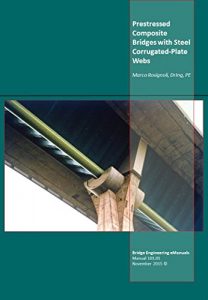Why using steel corrugated-plate webs in prestressed-concrete bridges instead of reinforced-concrete webs? Well, 25-35% lighter bridges (less concrete, reinforcement, post-tensioning and associated labor), enhanced flexural efficiency for additional savings in post-tensioning, less mass for better seismic response, use of thin unstiffened web plates for efficient use of modern high-grade steels, and compatibility with most construction methods for prestressed-concrete bridges are indeed good reasons to explain the interest for prestressed composite bridges in design-build pursuits.
The eBook explores the design and construction of prestressed composite bridges. It includes a statistical analysis of 165 bridges that shows substantial gain in structural efficiency. It explores state of stress in the corrugated-plate webs, torsion-distortion interaction in a box girder bridge, and the design of web-slab nodes and their connectors for local bending and shear. The eBook provides exhaustive coverage of the stability of corrugated-plate webs, local buckling, global buckling, interactive buckling, web crippling due to the traveling patch loads of incremental launching construction, and the resistance factors for the different failure modes of corrugated-plate webs.
Fully integrated within the Bridge Engineering eManuals © project, the eBook describes a step-by-step procedure to design the plate corrugation parameters for ultimate and serviceability load combinations, illustrates numerous case studies, and includes a comprehensive bibliography of 79 references.
The Bridge Engineering eManuals © project provides exhaustive coverage of new and emerging bridge construction technology and modern construction methods for all bridge professionals looking to save time, labor and costs, reduce risk, and increase the value and quality of bridge projects through mechanized construction. The eManuals share format and print styles to be collected into customized books, are immediately downloadable in PDF format from the author’s website www.marcorosignoli.com and as Kindle Editions from Amazon, and deliver a unique wealth of knowledge and learning.
Extracted from the bestseller “Bridge Construction Equipment” (2013, ICE Publishing) and the second edition of “Bridge Launching” (2014, ICE Publishing), the eBook expands the discussion from the 2-day classes of bridge launching and bridge construction technology that the author teaches for the ASCE Continuing Education Program and face-to-face in the offices of bridge owners, designers and constructors to provide exhaustive coverage of the topic.
The author may be reached at info@marcorosignoli.com
The eBook explores the design and construction of prestressed composite bridges. It includes a statistical analysis of 165 bridges that shows substantial gain in structural efficiency. It explores state of stress in the corrugated-plate webs, torsion-distortion interaction in a box girder bridge, and the design of web-slab nodes and their connectors for local bending and shear. The eBook provides exhaustive coverage of the stability of corrugated-plate webs, local buckling, global buckling, interactive buckling, web crippling due to the traveling patch loads of incremental launching construction, and the resistance factors for the different failure modes of corrugated-plate webs.
Fully integrated within the Bridge Engineering eManuals © project, the eBook describes a step-by-step procedure to design the plate corrugation parameters for ultimate and serviceability load combinations, illustrates numerous case studies, and includes a comprehensive bibliography of 79 references.
The Bridge Engineering eManuals © project provides exhaustive coverage of new and emerging bridge construction technology and modern construction methods for all bridge professionals looking to save time, labor and costs, reduce risk, and increase the value and quality of bridge projects through mechanized construction. The eManuals share format and print styles to be collected into customized books, are immediately downloadable in PDF format from the author’s website www.marcorosignoli.com and as Kindle Editions from Amazon, and deliver a unique wealth of knowledge and learning.
Extracted from the bestseller “Bridge Construction Equipment” (2013, ICE Publishing) and the second edition of “Bridge Launching” (2014, ICE Publishing), the eBook expands the discussion from the 2-day classes of bridge launching and bridge construction technology that the author teaches for the ASCE Continuing Education Program and face-to-face in the offices of bridge owners, designers and constructors to provide exhaustive coverage of the topic.
The author may be reached at info@marcorosignoli.com






